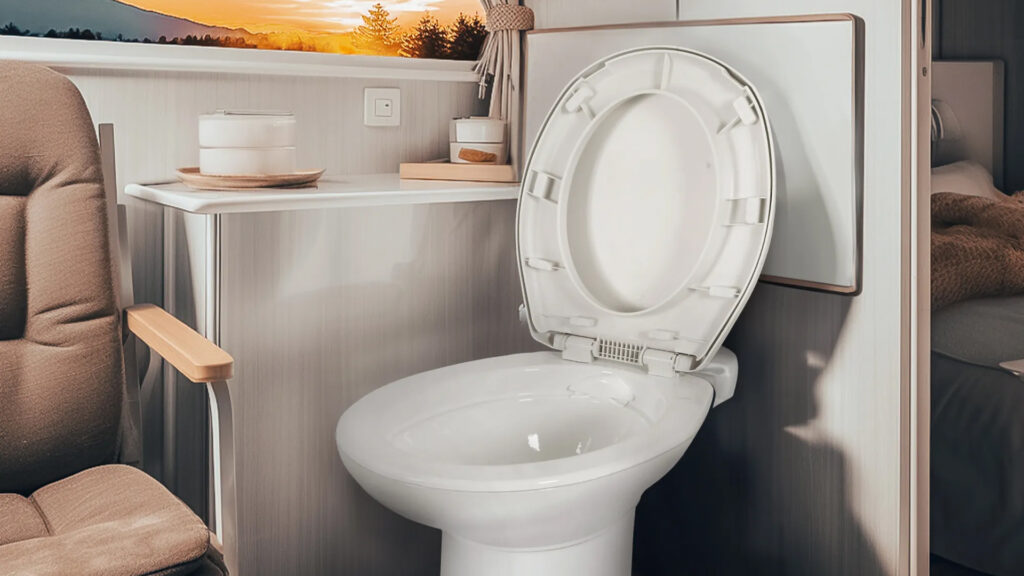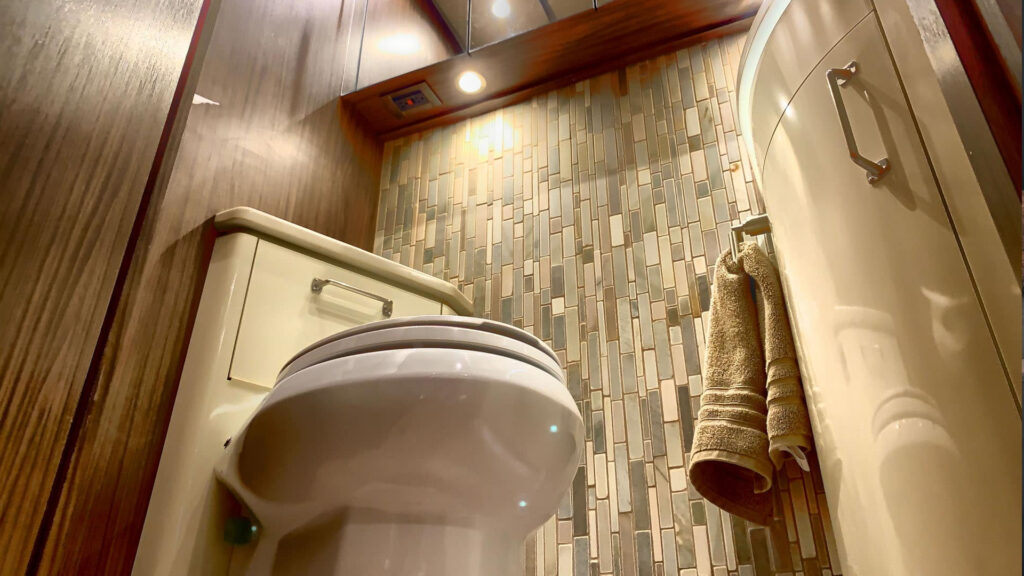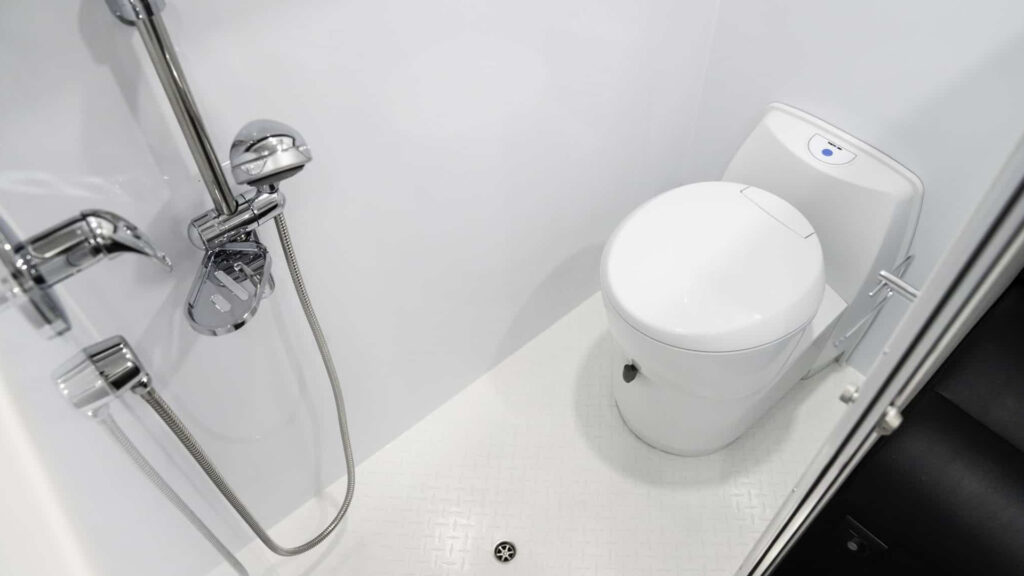Table of contents
When you’re new to RV life, one of the first questions you may ask is: how do RV toilets work? Unlike traditional home plumbing systems, RV toilets function on a different set of principles, requiring an understanding of water conservation, waste management, and regular maintenance. Whether you’re renting an RV for a weekend getaway or living in one full-time, understanding how RV toilets work is essential to ensure a smooth and sanitary experience on the road. So, how does a camper toilet work, and why does it matter? Knowing how to properly use and care for an RV toilet helps prevent unpleasant issues such as odors, clogs, or costly repairs. It also makes your journey more comfortable and efficient. How does an RV toilet work compared to your standard residential toilet? It uses less water, has fewer moving parts, and requires more hands-on care when it comes to waste disposal. In this guide, we’ll explore the basics of how RV toilets work, including the different types of RV toilets, their components, flushing mechanisms, water supply, and waste management systems. We’ll also provide maintenance tips and troubleshooting advice to keep your RV toilet running smoothly.
RV Toilet Basics: Understanding the System
Types of RV Toilet Systems
RV toilet systems come in several types, and the right one depends on the size and style of your rig. Let’s take a look at the most common types of RV toilets:
- Gravity-Flush Toilets: These are the most common in mid- to large-size RVs. They use gravity to drop waste into the black water tank directly below the toilet. Simple and effective, these toilets usually require manual flushing with a foot pedal.
- Vacuum-Flush Toilets: Found in some luxury RVs, these toilets use suction to move waste to the holding tank, allowing for more flexible tank placement. They use more components but offer improved odor control.
- Cassette Toilets: These are commonly found in smaller RVs or camper vans. Waste is stored in a removable cartridge that can be emptied manually. They’re compact and ideal for travelers without frequent access to dump stations.
- Composting Toilets: An eco-friendly option, these toilets separate liquid and solid waste, using natural processes to decompose the waste. They’re waterless and don’t require a black tank but do require regular emptying and maintenance.
- Portable Toilets: Lightweight and easy to transport, these are often used for tent camping or as an emergency backup. They consist of a toilet bowl with a small holding tank that can be emptied at designated sites.
Key Components of RV Toilet Systems
Regardless of the types of RV toilets, several components are universal across most systems:
- Toilet Bowl and Flushing Mechanism: Usually a foot pedal or hand lever that controls water flow and opens the valve to the black tank.
- Black Water Tank: Stores solid and liquid waste from the toilet.
- Fresh Water Tank: Supplies water to the toilet for flushing.
- Ventilation System: Allows gases to escape the black tank, preventing unpleasant odors.
- Waste Valve: Opens and closes the connection to the sewer hose during dumping.
These parts work together to make how RV toilets work both efficient and relatively simple with proper care.
How RV Toilets Operate

Step-by-Step Flushing Process
So, how does an RV toilet work when you flush? Here’s a breakdown:
- Pressing the Foot Pedal: Most RV toilets use a foot pedal. Lightly pressing the pedal adds a small amount of water to the bowl.
- Full Press to Flush: Pushing the pedal all the way down opens the waste valve and allows the contents of the bowl to drop into the black water tank.
- Seal Re-engagement: After flushing, the seal closes to prevent odor from rising back into the RV.
This is the basic answer to how does a camper toilet work. It’s all about gravity and water control. RV toilets don’t use a siphon like home toilets and usually have no standing water in the bowl, so flushing is a more direct process.
Water Supply Systems
Understanding how RV toilets work means knowing where the water comes from. There are two main sources:
- Onboard Freshwater Tank: If you’re dry camping, the toilet draws water from the RV’s internal fresh tank, using a pump to provide water pressure.
- Campsite Hookups: If connected to a water hookup, the RV uses that supply to fill the bowl. A pressure regulator ensures consistent water flow and prevents damage.
Water conservation is key in both setups. Using less water per flush helps extend your tank’s capacity, which is vital when you’re off-grid.
Waste Management System
How RV toilets work includes understanding how waste is stored. Waste goes into the black water tank, which you’ll need to empty regularly. Here’s how it works:
- Holding Capacity: Most tanks hold 20–40 gallons. How long it lasts depends on usage.
- Sensors: Installed in most tanks to show how full it is.
- Ventilation: Ensures gases escape properly, reducing odor issues.
When full, the tank must be emptied at a dump station, a crucial part of how does a camper toilet work.
Proper Use and Maintenance

RV-Specific Toilet Paper
Using the right toilet paper is critical. Here’s why:
- Breaks Down Easily: RV toilet paper is designed to dissolve quickly, preventing clogs in the black tank.
- How to Test: Place a few squares in water, shake the jar—if it dissolves fast, it’s safe.
- Where to Buy: RV supply stores, big box retailers, and online. Prices range from $5 to $10 per 4-pack.
Skipping this step can lead to blockages—definitely not how you want to learn how does an RV toilet work!
Chemical Treatments
RV toilet chemicals help break down waste and control odor. Common types include:
- Enzyme-Based: Natural and eco-friendly, they digest waste and tissue.
- Chemical-Based: Stronger but harsher, they neutralize smells quickly.
- Bacterial Treatments: Introduce beneficial microbes to manage waste.
Add treatments after each dump or weekly. They help keep your system running smoothly—another key part of how RV toilets work.
Emptying and Cleaning RV Toilets
Dumping the Black Tank
Emptying the tank is a necessary part of RV life. Here’s how:
- Connect to Dump Station: Use a sewer hose with a secure connection.
- Open Black Tank Valve: Let it drain fully.
- Flush with Clean Water: Use a tank rinser or flush valve.
- Close Valve, Add Treatment: Once clean, close the valve and treat.
Dump every 3–4 days or when 2/3 full. This is central to how does a camper toilet work over time.
Deep Cleaning Procedures
Periodically, go beyond regular cleaning:
- Tank Rinsing: Use a wand or built-in sprayer.
- Toilet Bowl Cleaning: Use RV-safe cleaners.
- Seal Maintenance: Lubricate with silicone-based products.
- Sensor Cleaning: Avoid soap scum or mineral build-up that causes false readings.
Proper deep cleaning ensures a long-lasting system, which is part of the bigger picture of how RV toilets work.
Troubleshooting Common RV Toilet Issues
Understanding how RV toilets work also means knowing how to fix common problems:
- Clogs: Use a flexible tank wand or approved enzyme treatment.
- Odors: Check the vent system, clean the tank, and use chemicals regularly.
- Leaks: Replace the seal or tighten fittings.
- Stuck Valves: Lubricate or replace them if they’re worn.
- Faulty Sensors: Clean thoroughly or replace if necessary.
In many cases, DIY fixes are possible, but if problems persist, consult a professional.
RV toilet systems may seem intimidating at first, but they’re surprisingly manageable with a bit of know-how. From understanding how RV toilets work to learning the differences between types of RV toilets, this guide offers all you need to keep your bathroom experience trouble-free. Whether you’re curious about how does a camper toilet work or trying to troubleshoot a flushing issue, mastering your RV toilet system ensures every adventure is clean, comfortable, and stress-free.
Ready to Master Your RV Toilet System? Stay Where Convenience Meets Adventure
Now that you know how RV toilets work, why not put your knowledge to the test at a park that makes everything easier? Black Hawk Creek RV Park offers full-hookup sites, making it the ideal destination for new and seasonal RVers looking for comfort, convenience, and unforgettable experiences. Nestled in the heart of South Dakota’s natural beauty and rich history, it’s the perfect basecamp for your first—or next—RV journey.
Book your stay today and make every part of your RV experience extraordinary!

